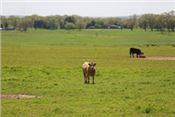|
Using Cattle To Overseed A Pasture ‘The Old-Fashioned Way’ Means Low Germination Rates

While the digestive process of livestock has always helped disperse plant seeds across fields and prairies, research
indicates it isn't a very effective way of trylu overseeding pastures.
Division of Agriculture photo.
LITTLE ROCK, ARK.
It is perhaps the oldest, most “natural” way to distribute plant seeds across a field: allow cattle to graze, roam freely, and let nature take its course.
John Jennings, extension forage specialist for the University of Arkansas System Division of Agriculture, said farmers and ranchers have asked him many times over the years if there might be a way to harness this cycle for effective grassland management.
“Can this natural process be harnessed to help overseed pastures with desirable species? We often get this question,” Jennings said. “Producers often report that they heard of someone that has had success feeding seed to animals or mixing it in minerals to let the animals seed their pastures.”
The data IS in
Jennings said there is a body of agronomic research that attempts to answer the question. Auburn University published a 1991 study examining the potential of livestock to spread toxic tall fescue seed. The researchers found that steers fed toxic fescue seed could pass seed in their manure with live endophyte for as long as 38 hours. The recovery rate of viable seed was 11.6 percent of the amount fed, and the amount of seed with live endophyte was 1.6 percent.
In 2017, researchers in North Carolina studied whether red clover seed, both coated and uncoated, could survive digestive tracts of cattle, after first mixing it with cattle mineral. They measured seed viability after passage through the animal, and also measured seedling establishment under field conditions.
The researchers found that coated seed had much lower survival than uncoated seed. After 14 days in contact with the mineral, 70 percent of the coated seed was not viable, and after 28 days all the coated red clover seed died. The uncoated seed survived for the full 28 days.
Next, they fed red clover seed to steers and found that germination rate dropped from 96 percent before feeding down to 14 percent after passage through the animal.
“So the journey through the digestive tract is definitely hazardous for seed survival,” Jennings said.
The 2017 study also examined the digested seeds’ chances of germinating and becoming established if the manure was manually broken up. Researchers found that by dragging fields to break up manure pats, they improved establishment somewhat, but only to the tune of one red clover seedling per square foot, on average.
“Without dragging, few seedlings survived,” Jennings said. “In contrast, the researchers found that when red clover was frost-seeded, 20 seedlings per square foot became established in pastures. So establishment rates for feeding seed were 95 percent less than for frost-seeding.”
Frost seeding is the practice of broadcasting seed over pastures during winter and letting the freezing/thawing action work the seed into the soil, Jennings said. It is a commonly recommended practice.
In 2007, Jennings and other Division of Arkansas researchers conducted a study in which strip-seeded white clover was no-till planted into fescue pastures.
The clover was planted at four times the normal seeding rate in strips across 25 percent of the field, so that the actual seeding rate was 8 lbs. per acre on the planted strips.
“By the numbers, we planted the total amount of the seed for a normal seeding rate recommended for each field, but only on 25 percent of the pasture area,” Jennings said. “Clover establishment was excellent in the strips.”
The pastures were rotationally grazed, he said, and after two years the unplanted areas between the strips had filled in well with clover, likely from seed being moved by the cattle.
“It’s unknown how much clover seed was consumed and moved by the cattle over both years, but I suspect the total amount was fairly high and dispersal occurred throughout each grazing season,” he said.
The bottom line
While the natural cycle of ingestion and elimination will help seed spread to some degree, it’s not a particularly efficient means of overseeding a pasture, Jennings said.
“All these studies showed that grazing animals can spread small amounts of viable seed that can become established in pastures,” he said. “But germination rates after digestive tract passage were in the range of 11-14 percent, and red clover seedling survival rates were about 95 percent lower than for direct planting methods.
“Animal dispersal of seed is a no-cost natural method that can be helpful if abundant seed is available in pastures,” he said. “But feeding limited amounts of expensive, purchased seed is a very inefficient way to overseed pastures with improved forages.” ∆
|
|